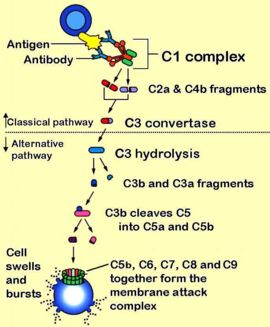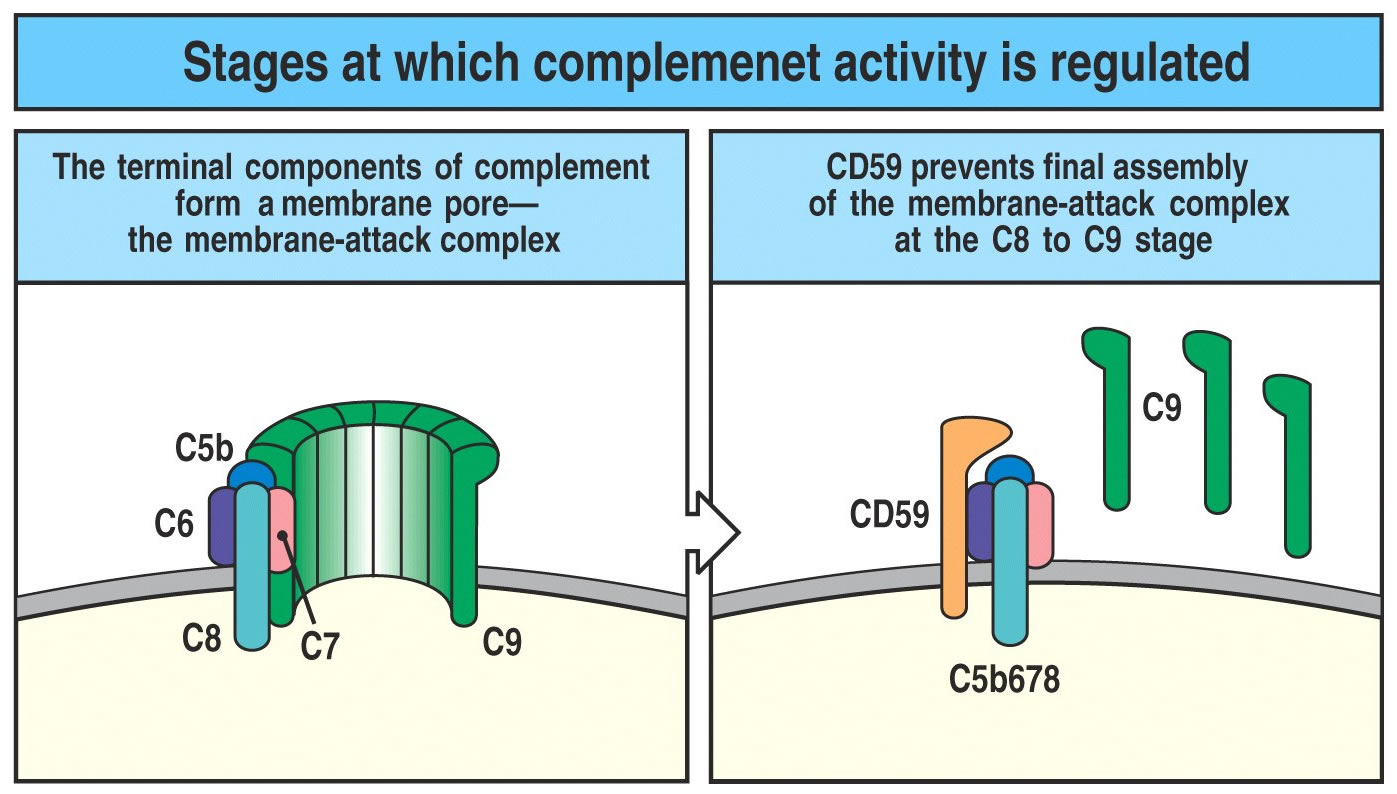*This web page was produced as an assignment for an undergraduate course at Davidson College.
Evasion of the Immune System
 Highly pathogenic strains of N. fowleri activate the alternative complement pathway but are resistant to lysis. On the surface of N. fowleri is a protein called CD59. CD59 inhibits the formation of the membrane attack complex with C9 and prevents the proliferation of T cells and their ability to produce cytokines (Friztinger, 2006). Therefore, living N. fowleri cannot be taken up by phagocytes nor can it be destroyed. Also, the amoebas are able to internalize antibodies on their surfaces and utilize the proteins as a food source. Sometimes, proteins of the complement system are able to attach to the N. fowleri. In this case, N. fowleri can isolate and shed portions of the membrane containing complement proteins. The shed membrane acts as a decoy, attracting more complement proteins that would otherwise attack the amoeba.
Highly pathogenic strains of N. fowleri activate the alternative complement pathway but are resistant to lysis. On the surface of N. fowleri is a protein called CD59. CD59 inhibits the formation of the membrane attack complex with C9 and prevents the proliferation of T cells and their ability to produce cytokines (Friztinger, 2006). Therefore, living N. fowleri cannot be taken up by phagocytes nor can it be destroyed. Also, the amoebas are able to internalize antibodies on their surfaces and utilize the proteins as a food source. Sometimes, proteins of the complement system are able to attach to the N. fowleri. In this case, N. fowleri can isolate and shed portions of the membrane containing complement proteins. The shed membrane acts as a decoy, attracting more complement proteins that would otherwise attack the amoeba.
The location of the N. fowleri infection contribute to its avoidance of detection by the immune system. The brain is not easily accessible to the cells of the immune system due to the presence of the blood-brain barrier (meninges), and so the parasites are partially protected from the immune system. Although the body is able to mount an immune response, the host is usually dead by then.
The immune system does not have time to fully mobilize its immune cell armies before the brain damage is so extreme that the organism dies.
If N. fowleri encounters a phagocyte, it is thought that N. fowleri is able to release a second set of proteins that decreases the activity of other phagocytes. It is unknown as to how this is accomplished.
http://content.answers.com/main/content/wp/en-commons/thumb/1/1b/270px-Complement.jpg

However, if the host lives long enough, the immune system response gains strength, the most common symptoms of infection become more and more obvious. At first, the parasites are simply unable to hide from the immune cells, and cannot pretend to be part of the host’s body anymore. Over time, the immune system response catches up. More antibodies and complement proteins are released, more phagocytes are born, and more blood and immune cells rush to the parasitic sites. The brain becomes swollen, which often leads to seizures and compression of the surrounding brain tissue. The immune response causes irreparable brain damage to the areas of the brain around the N. fowleri as the phagocytes ingest the cells surrounding the N. fowleri, which also contributes to the seizures.
N. fowleri is a free-living organism, which means that it can survive without a host. This explains why N. fowleri attacks are so rapid and fatal. Since hosts are not necessary to its survival, the parasite does not have to avoid killing them. (Manzo, 2003)
http://bio.davidson.edu/Courses/Immunology/Students/spring2006/Dresser/CD59%20004.jpg
Home
Life Cycle
Humoral Immune Response
Cellular Immune Response
Evasion of The Immune System
Treatment
References

If you have any question or suggestions regarding this site, please contact Alex Kim (alkim@davidson.edu)
 Highly pathogenic strains of N. fowleri activate the alternative complement pathway but are resistant to lysis. On the surface of N. fowleri is a protein called CD59. CD59 inhibits the formation of the membrane attack complex with C9 and prevents the proliferation of T cells and their ability to produce cytokines (Friztinger, 2006). Therefore, living N. fowleri cannot be taken up by phagocytes nor can it be destroyed. Also, the amoebas are able to internalize antibodies on their surfaces and utilize the proteins as a food source. Sometimes, proteins of the complement system are able to attach to the N. fowleri. In this case, N. fowleri can isolate and shed portions of the membrane containing complement proteins. The shed membrane acts as a decoy, attracting more complement proteins that would otherwise attack the amoeba.
Highly pathogenic strains of N. fowleri activate the alternative complement pathway but are resistant to lysis. On the surface of N. fowleri is a protein called CD59. CD59 inhibits the formation of the membrane attack complex with C9 and prevents the proliferation of T cells and their ability to produce cytokines (Friztinger, 2006). Therefore, living N. fowleri cannot be taken up by phagocytes nor can it be destroyed. Also, the amoebas are able to internalize antibodies on their surfaces and utilize the proteins as a food source. Sometimes, proteins of the complement system are able to attach to the N. fowleri. In this case, N. fowleri can isolate and shed portions of the membrane containing complement proteins. The shed membrane acts as a decoy, attracting more complement proteins that would otherwise attack the amoeba.
